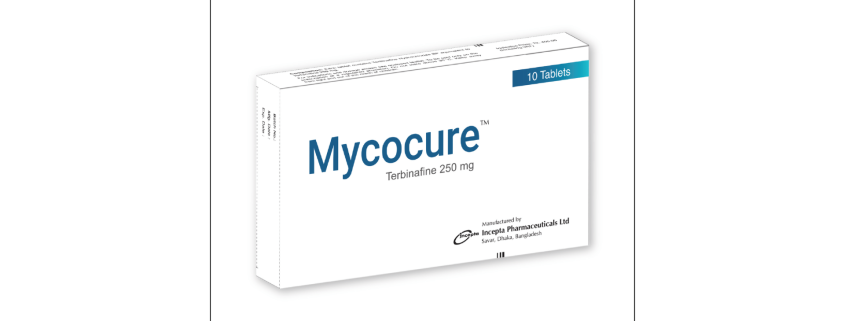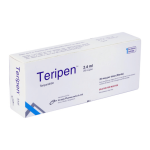Mycocure(Terbinafine)

Therapeutic Group: Terbinafine Hydrochloride BP
Presentation
Mycocure 250 Tablet: Each tablet contains Terbinafine Hydrochloride BP equivalent to Terbinafine 250 mg.
Description
Terbinafine, an allylamine antifungal, inhibits biosynthesis of ergosterol, an essential component of fungal cell membrane, via inhibition of squalene epoxidase enzyme. This results in fungal cell death primarily due to increased membrane permeability mediated by accumulation of high concentrations of squalene. Depending on the concentration of the drug and the fungal species test in vitro, terbinafine hydrochloride may be fungicidal. Following oral administration, terbinafine is well absorbed (>70%) and the bioavailability as a result of first pass metabolism is approximately 40%. Approximately 70% of the administered dose is eliminated in the urine.
Indications
Terbinafine is indicated for the treatment of the following infections:
• Onychomycosis
• Fungal infections of the skin (Tinea pedis, Tinea corporis, Tinea cruris) caused by Trichophyton rubrum, Epidermophyton floccosum, Microsporum canis.
Dosage & Administration
For adults
Onychomycosis- 250 mg tablet once daily for 6 weeks (for finger nail) or 12 weeks (for toe nail).
Tinea cruris- 250 mg tablet once daily for 2-4 week
Tinea pedis- 250 mg tablet once daily for 2-6 weeks
Tinea corporis- 250 mg tablet once daily for 4 weeks
For pediatric
The safety and efficacy of Terbinafine tablets have not been established in pediatric patients.
For elderly
Same as adults
Side Effects
Side effects are generally mild to moderate, and transient. Most common side effects are gastrointestinal problems such as diarrhea, dyspepsia and abdominal pain, nausea, vomiting, urticaria, pruritis, taste disturbance. Adverse effects such as neutropenia, vertigo, vasculitis, new or worsening lupus (auto-immune disorder) are rarely observed.
Precautions
Terbinafine tablets are not recommended for patients with chronic or active liver disease. Before prescribing, pre-existing liver disease should be assessed. Hepatotoxicity may occur in patients with and without pre-existing liver disease. Patients with persistent nausea, anorexia, fatigue, vomiting, right upper abdominal pain or jaundice, dark urine or pale stools, progressive skin rash symptoms should discontinue taking oral terbinafine and the patient’s liver function should be immediately evaluated.
Use in Pregnancy & Lactation
Pregnancy: Pregnancy category B. There are no adequate and well-controlled studies in pregnant women. In animal studies, no evidence of impaired fertility or harm to the fetus due to terbinafine has been reported.
Lactation: Terbinafine is excreted in breast milk. Therefore, oral treatment with Terbinafine tablets should be avoided during lactation.
Drug Interaction
Terbinafine is an inhibitor of CYP4502D6 isoenzyme and has an effect on metabolism of decsipramine, cimetidine, fluconazole, cyclosporine, rifampin and caffeine.
Over Dose
Clinical experience regarding overdose with oral terbinafine is limited. Doses up to 5 grams (20 times the therapeutic daily dose) have been taken without inducing serious adverse reactions. The symptoms of overdose included nausea, vomiting, abdominal pain, dizziness, rash, frequent urination, and headache.
Commercial Pack
Mycocure 250 tablet: Each box contains 1 blister strip of 10 tablets



